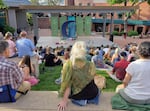
With outdoor seating, a wide beer list and ample parking for mountain bikers, Gil's tap house stayed busy during the pandemic.
Juliet Grable / JPR News
If you’ve visited Ashland lately, you may have been struck by how normal it all feels. Tourists stroll down Main Street, most of them maskless. Diners throng the outdoor seating along Calle Guanajuato, the pedestrian way along Ashland Creek. Lithia Park is lush from recent rains. The Oregon Shakespeare Festival is in full swing. You can almost forget we’re just emerging from more than two years of a pandemic and that we’re still in the throes of a record drought.
Make no mistake: the COVID-19 pandemic hit Ashland hard. It came on the heels of two smoky summers, during which several performances of the festival, Ashland’s anchor attraction, were canceled. OSF went dark for all of 2020 and most of 2021.
“Pre-pandemic, we had people who had been coming to Ashland for 20-plus years,” says Drew Gibbs, owner of the Winchester Inn and two Ashland restaurants, Alchemy and Chateaubriand 36. “They were people who wanted to book the same weekend every year. They didn’t care what was playing at OSF; they’d be there.”
While festival patrons, many of them older, wealthy retirees, stayed away, others came, once the first wave of the pandemic receded. When Gibbs talked to his customers, he learned they were there to go mountain biking or on wine tours, or were simply passing through on their way to somewhere else.
Katharine Cato, director at Travel Ashland, says the Southern Oregon town’s visitor base was evolving well before COVID. “We’ve seen it coming, with poor air quality, an aging OSF audience, changing loyalties, and a new type of visitor coming to Ashland,” she says. “The pandemic simply broke everything open.”
Survey says
Ashland’s economy is grounded in tourism. Historically, says Cato, OSF has been responsible for about 120,000 unique visitors per year — over one third of Ashland’s annual tourist traffic.
Travel Ashland is responsible for promoting Ashland as a tourist destination and ultimately, helping fuel the town’s economy. Every year they track trends and plan accordingly. In November 2020, nearly a year into the pandemic, Travel Ashland hired Destination Analysts, a firm based in San Francisco, to conduct a visitor research and analyses study to better understand the new tourists coming to Ashland.

A free "Green Show" performance outside of the Oregon Shakespeare Festival's Allen Elizabethan Theater. During the 2022 season OSF is offering eight live performances, three virtual shows and reduced ticket pricing in what a spokesperson described as an effort to increase accessibility.
Juliet Grable / JPR News
Surveys of 1,500 “leisure travelers” from key markets across the region helped them learn why people traveled and how their impressions of Ashland compared to other destinations in the region. The surveys showed that visitors could be lured to Ashland for its small, walkable downtown, proximity to rivers and lakes, and award-winning cuisine and culinary festivals. Uncrowded trails and cultural attractions are also draws.
At the same time, respondents viewed Ashland primarily as an outstanding arts and culture destination. They ranked Healdsburg, Lake Tahoe and Bend more highly when it comes to wine, food, and outdoor recreation. Now, Travel Ashland is trying to change that perception.
For Hiram Towle, general manager at Mt. Ashland Ski Area who also serves on the Travel Ashland Advisory Committee, the study confirmed what he already knew.
“The smoke, the Almeda Fire, and COVID cast a bright light on the need to make sure we’re working toward diversification in our visitor economy,” he says. “We’ve always known we had great recreation opportunities, but we didn’t crow about them. We were satisfied with filling restaurants and hotels with OSF patrons.”
A fresh look
When you visit Travel Ashland’s Instagram page, you’ll find eye candy: dancers in colorful costumes for the Ashland World Music Festival; a panorama of the vineyards at Belle Fiore winery; the cascades at Mill Creek Falls.
The social media page is just one aspect of a rebranding campaign Travel Ashland launched in response to the visitor study. A Bend-based firm called Intently Collaborative spearheaded the effort.
The new brand strives to portray Ashland as a modern mountain community with a broad array of amenities and easy access to nature and outdoor recreation. New colors — teal, blue, and a sunny gold — infuse Travel Ashland’s revamped website and the latest visitor’s guide. The Shakespearian tagline — Ashland: As you like it — has been updated with the more active Ashland: Live your daydreams.
The intent is not to replace OSF and play-going, Cato explains, but to elevate the other types of experiences Southern Oregon offers: food and wine tasting; an afternoon at the spa; skiing on Mt. Ashland.
Here, she argues, Ashland has advantages, even if people haven’t discovered them yet.

Fresh snow at Mt. Ashland in January 2021. The local ski resort had some of their most successful seasons during the pandemic.
Erik Neumann / JPR News
For example, people flocked to ski slopes during the pandemic, seeking COVID-safe recreation, but at larger, better known resorts, the experience was marred by traffic and long lift lines.
“People were seeing that in the news, and that was driving them to go to places where there is still capacity,” says Towle, adding that Mt. Ashland saw record visitorship last year, despite the less than stellar snow.
For similar reasons, the Rogue Valley’s uncrowded tasting rooms have an advantage over better known wine regions, says Gibbs.
“Napa is like the Disneyland of the wine world,” says Gibbs. “Here you can show up and the winemaker might be standing right there and offer to show you around.” The combination of quality and casual is appealing to a lot of people, he adds, citing his newest restaurant, Chateaubriand 36, as the type of place that satisfies foodies but without the stuffy vibe.
Travel Ashland wants to shed the perception that Ashland is too expensive, or elitist. An important goal of the rebranding effort, says Cato, is sending a clear message that all are welcome — and that you can visit Ashland without breaking the bank.
In their rebranding campaign, Contently Co. identified four “lifestyle personas” they hope to target through marketing: families looking for a stress-free vacation with kid-friendly activities; friends meeting up in Ashland, travelers seeking a quick getaway; and wanderers on the hunt for a scenic home base from which to explore Rogue Valley wineries.
Towle has been talking with other outdoor recreation business owners about how to better support visitors who come to ski, raft, bike, and fish. They note a need for better signage and more camping options in or close to town, including places where people can safely sleep in their vans or campers.
Right now, and unlike other ski resorts, the parking lot at Mt. Ashland isn’t set up to accommodate campers, though people do spend the night there, says Towle.
“We’ve seen it coming, with poor air quality, an aging OSF audience, changing loyalties, and a new type of visitor coming to Ashland. The pandemic simply broke everything open.”
The number of bed and breakfast inns has plummeted from over 30 to just 10. While some owners have simply retired, others have converted their inns to self-service vacation rentals, which not only feel safer during a pandemic, but cater to younger, tech-savvy travelers.
“You’ve got [restaurants] like Ruby’s and Growler Guys and Skout that really do appeal to the outdoor traveler,” says Towle. Even simple things like having a safe place to put your bicycle matter, he adds.
A one-two punch
A healthy OSF is vital to Ashland’s economy. The festival claims its state economic impact was over $120 million in 2019, the year before the pandemic. Blake Zidell, OSF’s press representative, told JPR that OSF is responsible for a full 20% of overall economic activity in the Rogue Valley.
In 2018, OSF canceled or moved 26 performances and lost nearly $2 million because of wildfire smoke.
On May 8, 2020, amid statewide pandemic restrictions, OSF canceled the rest of its 2020 season.
OSF reopened with a limited season in 2021, but in August, most of the performances of the festival’s only running show were canceled because of smoke.
OSF has received $14.71 million in pandemic relief funds, including $10 million through the federal Shuttered Venue Operators grant program.
The relief funding helped OSF offset its pandemic-related losses, says Zidell. “[It did not] put OSF ahead of where the organization was, financially, before the pandemic.” The festival is still struggling with staffing shortages.
Ashland’s retail stores and restaurants are still trying to recover from the festival’s closure and stop-start jolts of the pandemic. Those who remained on staff during COVID saw fewer shifts, fewer customers, and a drastic cut in wages. Gibbs credits strong support from locals and services like DoorDash for keeping his restaurants afloat. The Paycheck Protection Program and the Restaurant Revitalization Fund were godsends, although, says Gibbs, only one third of restaurateurs who applied to the Revitalization Fund received assistance (He was not one of them.)

Standing Stone Brewing Company closed in Ashland after 26 years. Managers cited reduced tourist traffic during the pandemic, smoky summers and the difficult job market.
Juliet Grable / JPR News
For some, the aid was not enough. On May 10, Standing Stone Brewing Company, a fixture in downtown Ashland for 26 years, announced it would close permanently at the end of the month.
Elisha Lewis, manager at Standing Stone, cites a combination of blows that made recovering impossible, starting with smoky summers that reduced tourist traffic. The spike in the cost of goods and a “frustrating” job market have only added to the challenges.
“As managers, we were left with a much smaller workforce to recruit from,” says Lewis. “We continued to offer higher, competitive wages, but we weren’t seeing quality candidates apply.”
The mass exodus from the restaurant biz is a national trend, and data from the Bureau of Labor Statistics show that “quit rates” remain higher in foodservice than in any other industry.
Gibbs was having trouble filling shifts at his two restaurants, so he cut service from five nights a week down to four. Other restaurants are still operating with skeleton crews and have switched to counter service.
The area’s housing woes are not helping retain service workers. In Ashland, average home prices and rents were already significantly higher than most of Jackson County before the Almeda Fire devastated the valley. The fire wiped out at least 2,500 dwellings between Ashland and Medford, many of them below market rate.
Meanwhile, warming temperatures and a prolonged drought are helping fuel wildfires across the West, all but guaranteeing weeks of compromised air quality at the peak of summer.
“I believe that smoky wildfire seasons are here to stay,” says Lewis. “I personally don’t have a lot of hope that Ashland in particular will see the same influx of tourists as we did years ago.”
Ashland by the numbers
Appealing to visitors through the seasons will be important going forward, given the likelihood of smoky skies in August. One way Travel Ashland will track their progress is through two city taxes: the 10% Transient Occupancy Tax, or TOT, and the 5% tax on prepared foods and beverages, which some refer to as the “meals tax.” The TOT is the most closely tied to tourism; it applies to every temporary lodging in town, whether a vacation rental, hotel room, or B&B.
Not surprisingly, revenues from both taxes plunged during the pandemic, but Cato says Ashland recovered more quickly than almost every other region in Oregon, except for the coast.
After a dismal quarter in spring of 2020, revenues from the TOT bounced back slightly that summer. TOT revenues remained depressed throughout 2020 and into 2021, but toward the end of the year, they rebounded. The October through December quarter brought in $533,830 — nearly $100,000 more than that same period in 2020, and not far below 2019 or 2018 levels.
“We’ve heard anecdotally from our partners that the end of 2021 was one of the strongest (third quarters) they’ve ever experienced,” says Cato, adding that lodging owners were able to keep their room rates up through this period. “There’s some momentum afoot.”
After months of feeling penned in by the pandemic, many people were finally feeling safe enough to travel in the window between Delta and Omicron waves. Some were lured by Mt. Ashland’s exceptional early powder and OSF’s first ever holiday production, It’s Christmas, Carol!
“We had people showing up in December just to go to that show,” says Gibbs. “This year it will be even better.”
The holiday show is but one example of how the festival is adjusting to new realities and attempting to attract new playgoers.
“We have the arts and culture; we’re not stepping away from that. We’re just constantly building upon it.”
In 2022, the first full season under Artistic Director Nataki Garrett, OSF is offering eight live shows and three virtual productions. The company has done away with its “dynamic pricing” model, where ticket prices fluctuated with demand; instead, ticket prices are fixed and have been slashed across the board. Prices range from $35 to $75, whereas top tickets used to go for $132.
Garrett and Executive Director David Schmitz instituted these changes “to increase accessibility and inclusion and to lead the American theater at large in that direction,” says Zidell. They are also a response to the declining audience numbers Garrett and Schmitz inherited when they joined OSF, he adds. According to data from OSF’s annual reports, attendance, as measured by percentage of theater seats filled, had declined in the years leading up to the pandemic. In the years from 2006 to 2015, attendance percentages ranged in the high 80s to low 90s; in the period from 2016 to 2019, they had dipped to the low to mid 80s.
The 2022 schedule is also staggered so that fewer shows are running in late summer, when it’s often smoky. Two shows close at the end of July and two new shows open in mid and late August.
The challenges are not going away. Inflation, high gas prices, and another drought-fueled fire season may yet dampen enthusiasm for travel. On the other hand, a whole new group of people may catch wind of Ashland’s world-class mountain biking trails or wine scene, load up the car, and go—and catch a play while they’re at it.
“We have the arts and culture; we’re not stepping away from that,” says Cato. “We’re just constantly building upon it.”